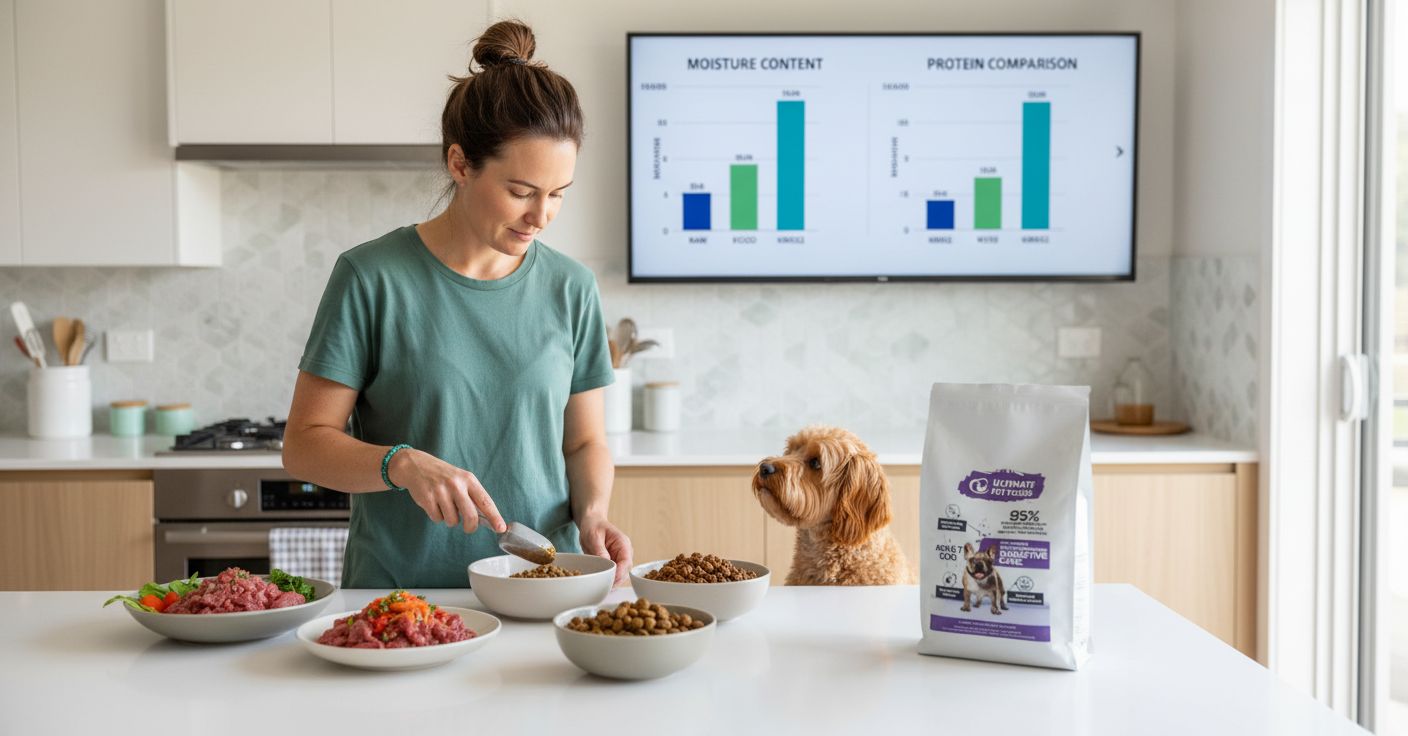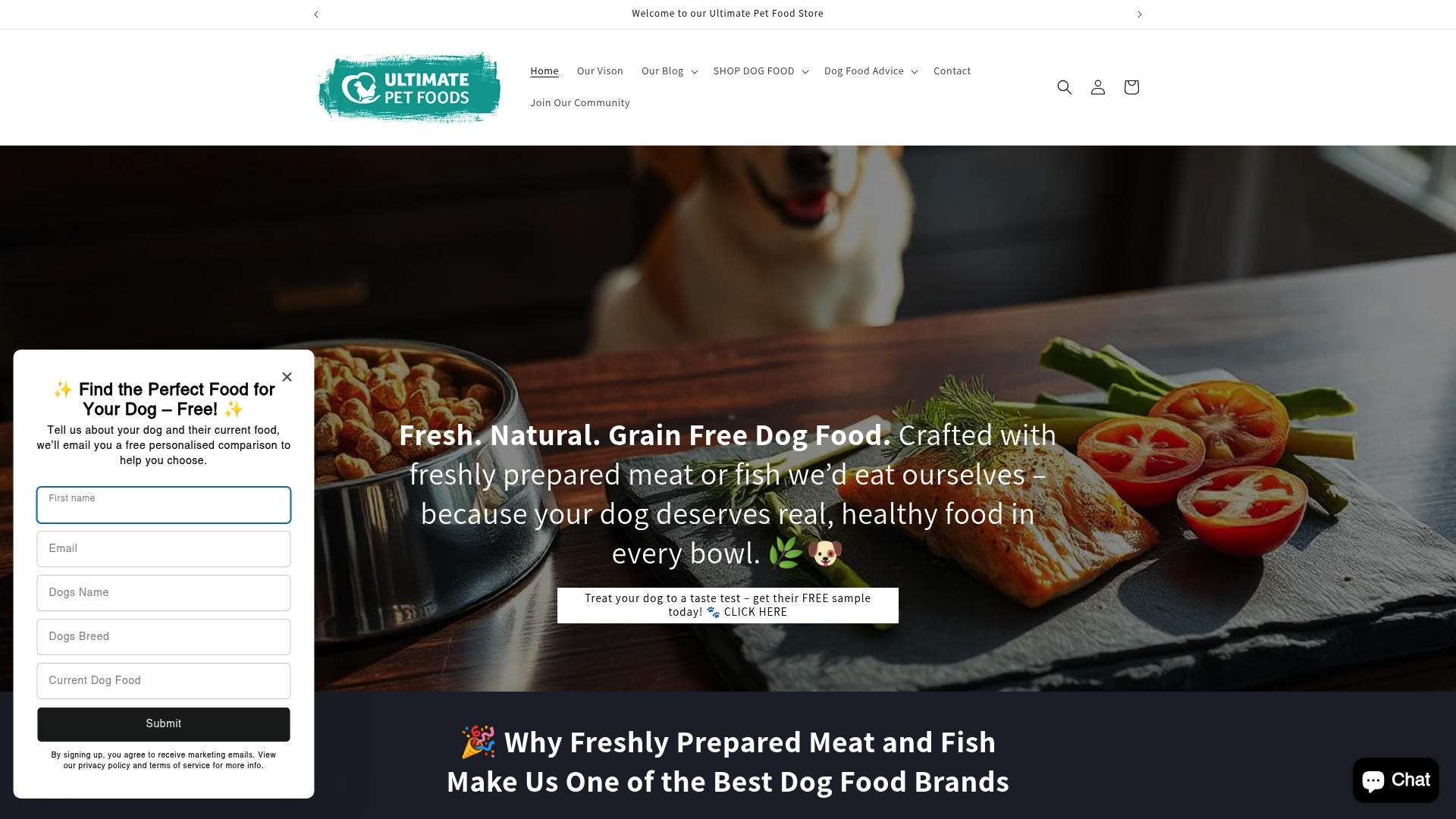
Dog Food Explained: Types, Nutrition, and Best Choices
Share
Over half of pet owners still believe all dog foods are created equal, yet scientific studies reveal striking differences in quality and nutritional value. What goes into your dog’s bowl matters for their long-term health, from energy levels to allergy prevention. Understanding the real definition of dog food and separating myths from facts helps you make smarter choices that keep your canine companion thriving.
Table of Contents
- Dog Food Defined And Common Misconceptions
- Types Of Dog Food And Key Differences
- Nutritional Needs For Different Breeds And Life Stages
- Benefits Of Grain-Free And Natural Formulas
- Risks, Allergies, And Choosing The Best Option
Key Takeaways
| Point | Details |
|---|---|
| Understanding Dog Food | Dog food is a meticulously formulated nutritional package catering to canines’ dietary needs, differing significantly in quality and composition. |
| Diverse Dog Food Types | Key dog food options include dry kibble, wet food, and raw diets, each offering distinct benefits related to nutrition and palatability. |
| Life Stage Nutrition | Dogs require tailored nutrition at different life stages, emphasizing the importance of age-specific dietary formulations for optimal health. |
| Grain-Free Advantages | Grain-free and natural formulas can improve digestibility and overall health, particularly for dogs with sensitivities or nutritional needs. |
Dog Food Defined And Common Misconceptions
Understanding what constitutes dog food goes far beyond simply filling a bowl with kibble. According to research from nutritional experts, dog food is a precisely formulated nutritional package designed to provide complete dietary requirements for canines across different life stages and health conditions.
Many pet owners fall prey to common misconceptions about commercial dog foods. One prevalent myth is that all dog foods are nutritionally equivalent, which scientific analysis clearly disproves. Understanding Dog Foods to Avoid for Optimal Health reveals significant variations in ingredient quality and nutritional profiles.
Key characteristics of high-quality dog food include:
- Balanced nutritional profile matching canine dietary needs
- Ingredients sourced from human-grade protein sources
- Tailored formulations for specific life stages
- Minimal processing to preserve nutrient integrity
Our kibble, gentle cooked at 82°C, represents a premium approach to nutrition. By using freshly prepared meat or fish and incorporating prebiotics like MOS and FOS, we ensure your dog receives optimal nutrition that supports overall health and vitality. The goal is not just feeding, but nourishing your canine companion with scientifically backed, carefully crafted nutrition.
Types Of Dog Food And Key Differences
Dog nutrition has evolved significantly, presenting pet owners with multiple food options to support their canine companions’ health. Understanding Raw vs Kibble Dog Food: Key Insights highlights the critical differences between various dog food types, each offering unique nutritional profiles and benefits.
According to research, the primary dog food types include dry kibble, wet food, and raw food. Dry kibble remains the most popular choice, offering convenience, nutrient density, and easy storage. Wet food provides higher moisture content, which can be beneficial for dogs with hydration needs, while raw food mimics a dog’s ancestral diet but requires meticulous handling to prevent potential bacterial contamination.
Key characteristics of different dog food types include:
Here’s a comparison of the key features of common dog food types:
| Feature | Dry Kibble | Wet Food | Raw Food |
|---|---|---|---|
| Convenience | High Easy storage |
Moderate Requires refrigeration |
Low Needs careful handling |
| Moisture Content | Low | High | Variable |
| Protein Content | Moderate | Moderate | High |
| Palatability | Good for most dogs | Very palatable | Highly palatable |
| Processing Level | Processed Shelf-stable |
Processed Less shelf-stable |
Minimally processed |
| Dental Benefit | Supports dental health | Minimal benefit | Minimal benefit |
| Typical Cost | Cost-effective | More expensive | Most expensive |
- Dry Kibble:
- Nutrient-dense and shelf-stable
- Cost-effective
- Supports dental health through crunchy texture
- Wet Food:
- Higher moisture content
- More palatable for picky eaters
- Softer texture for senior dogs
- Raw Food:
- Closest to natural canine diet
- Minimally processed
- Higher protein content
Our kibble represents a premium approach, gentle cooked at 82°C to lock in nutrients from freshly prepared meat or fish.
 By incorporating human-grade ingredients and prebiotics like MOS and FOS, we ensure a balanced, nutritionally complete meal that supports your dog’s overall health and vitality. The goal is providing scientifically crafted nutrition that goes beyond mere sustenance.
By incorporating human-grade ingredients and prebiotics like MOS and FOS, we ensure a balanced, nutritionally complete meal that supports your dog’s overall health and vitality. The goal is providing scientifically crafted nutrition that goes beyond mere sustenance.

Nutritional Needs For Different Breeds And Life Stages
Understanding canine nutrition requires recognising that dogs have dramatically different dietary requirements throughout their lifetime. Understanding Life Stage Dog Food: Nutrition by Age highlights the critical importance of tailoring nutrition to each specific developmental phase.
Research demonstrates that nutritional needs vary significantly across puppy, adult, and senior life stages. Puppies require higher protein and calorie content to support rapid growth, while adult dogs need balanced nutrition for maintenance, and senior dogs benefit from reduced calorie intake with enhanced joint and cognitive support nutrients.
Nutritional requirements are influenced by several key factors:
- Breed Size:
- Small breeds metabolise food faster
- Large breeds need controlled calcium for bone development
- Giant breeds require specific joint support nutrients
- Activity Level:
- Working dogs need high-energy formulations
- Sedentary dogs require lower-calorie diets
- Age-Specific Needs:
- Puppies: High protein, support growth
- Adults: Balanced maintenance nutrition
- Seniors: Lower calories, joint and cognitive support
Our kibble, gentle cooked at 82°C, incorporates human-grade ingredients and prebiotics like MOS and FOS to provide tailored nutrition across different life stages. By using freshly prepared meat or fish and understanding individual nutritional requirements, we ensure your dog receives precise, scientifically crafted nutrition that supports their unique health journey.
Benefits Of Grain-Free And Natural Formulas
Navigating the world of dog nutrition reveals compelling advantages for grain-free and natural food formulas. Understanding the Benefits of Grain Free Diet for Dogs highlights the critical considerations for pet owners seeking optimal dietary solutions for their canine companions.
Research demonstrates that grain-free diets can offer significant health benefits for dogs with specific sensitivities or allergies. These formulas typically focus on high-quality protein sources and eliminate common grain-based ingredients that might trigger digestive issues or inflammatory responses in some dogs.
Key benefits of grain-free and natural dog food formulas include:
- Improved Digestibility:
- Easier to process for dogs with sensitive stomachs
- Reduced likelihood of food-related allergic reactions
- Minimised digestive inflammation
- Nutritional Advantages:
- Higher protein content
- More concentrated nutrient profiles
- Focus on whole, natural ingredients
- Potential Health Improvements:
- Better skin and coat health
- Enhanced energy levels
- Potential reduction in food-related sensitivities
Our kibble, gentle cooked at 82°C, represents the pinnacle of grain-free nutrition. By incorporating human-grade ingredients, freshly prepared meat or fish, and prebiotics like MOS and FOS, we ensure a scientifically crafted formula that supports your dog’s overall health and vitality. We understand that every dog is unique, and our approach reflects a commitment to providing tailored, natural nutritional solutions.
Risks, Allergies, And Choosing The Best Option
Navigating the complex world of dog nutrition requires careful consideration of potential risks and individual dietary needs. What Ingredients to Avoid in Dog Food for Healthier Pups provides essential insights into selecting the most appropriate diet for your canine companion.
Research highlights that dietary risks can emerge from various food choices, including potential nutritional imbalances, allergenic ingredients, and exposure to inappropriate nutrients. Food allergies in dogs can manifest through symptoms like skin irritation, digestive issues, and chronic inflammation, making it crucial to understand your dog’s specific dietary sensitivities.
Key considerations when choosing dog food include:
- Allergy Identification:
- Watch for skin rashes
- Monitor digestive changes
- Note behavioral shifts after eating
- Nutritional Risk Management:
- Avoid common allergens
- Seek hypoallergenic options
- Consider limited ingredient diets
- Professional Guidance:
- Consult veterinary nutritionists
- Conduct elimination diet trials
- Regular health monitoring
Our kibble, gentle cooked at 82°C, represents a scientifically crafted solution. By incorporating human-grade ingredients, freshly prepared meat or fish, and prebiotics like MOS and FOS, we ensure a nutritionally balanced formula that minimises potential allergenic risks. We understand that every dog’s nutritional journey is unique, and our approach focuses on providing safe, tailored nutrition that supports optimal health and well-being.
Discover the Best Nutrition for Your Dog’s Unique Needs
Choosing the right dog food can feel overwhelming with so many types and formulas available. This article highlighted how nutrition tailored to your dog’s breed, age and health is essential for vitality and wellbeing. Many dog owners wrestle with questions about grain-free options, balanced nutrition and allergen concerns.
Explore our premium range of Dry Dog Food | Grain-Free & Science-Backed Kibble that is crafted with fresh, human-grade ingredients and gentle cooking to preserve nutrients. Each formula supports specific life stages and dietary needs, from puppies to seniors, so your dog gets exactly what they require.

Take action today to transform mealtimes into nourishing moments your dog will thrive on. Visit Ultimate Pet Foods to discover our full Salmon Dog Food – Premium, Healthy, Hypoallergenic & Omega-Rich selection and find the perfect match for your companion. Give your dog the gift of scientifically backed, natural nutrition they deserve.
Frequently Asked Questions
What are the main types of dog food available?
The primary types of dog food include dry kibble, wet food, and raw food. Dry kibble is convenient and nutrient-dense, wet food offers higher moisture content and palatability, while raw food mimics a dog’s ancestral diet but requires careful handling.
How do I choose the right dog food for my dog’s life stage?
Choosing the right dog food depends on your dog’s life stage: puppies require high protein and calorie content for growth, adults need balanced nutrition for maintenance, and seniors benefit from lower calories with nutrients for joint and cognitive support.
What are the benefits of grain-free dog food?
Grain-free dog food can improve digestibility, reduce the likelihood of food-related allergies, and generally offer higher protein content with a focus on whole, natural ingredients, making it suitable for dogs with sensitivities to grains.
How can I identify food allergies in my dog?
To identify food allergies in your dog, watch for symptoms such as skin rashes, digestive issues, and behavioral changes after eating. Consulting with a veterinarian is crucial for diagnosis and developing an appropriate diet plan.
Recommended
- Understanding Raw vs Kibble Dog Food: Key Insights – Ultimate Pet Foods
- What is Kibble? Understanding Dog Food Choices – Ultimate Pet Foods
- How to Choose Dog Food: A Step-by-Step Guide for Healthy Dogs – Ultimate Pet Foods
- Understanding Common Dog Food Ingredients for Healthier Pups – Ultimate Pet Foods
- Understanding What is a Dietary Supplement: A Deep Dive – MyGymSupplements
- Best Picks & Buying Guides | Parent Kitchen Lab
